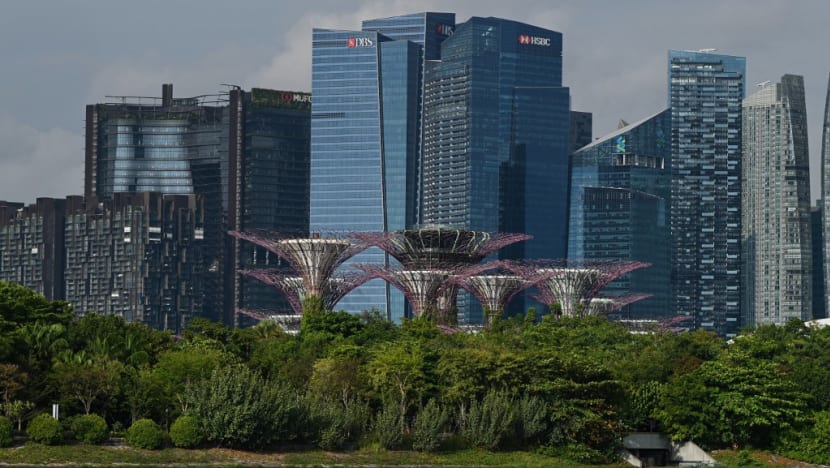From generation to generation: How family businesses adapt to changing environments
While family businesses are known to be resilient, the COVID-19 pandemic has pushed many to rethink their legacies. Money Mind looks at how family businesses are transforming to adapt to a disruptive digital environment.

A general view shows the skyline of the central business district in Singapore on Oct 20, 2021. (Photo: AFP/Roslan Rahman)
SINGAPORE: Behind the grandeur of buildings that dot Singapore’s skyline, the engine of facilities management is always in full gear.
For more than 30 years, family firm Kim Yew Integrated has been among those making sure government offices and landmarks are not only safe, but a sight to behold.
The company was founded by Mr Jim Tan, who arrived in Singapore in the 1970s from Malacca.
He started working as an electrician, and in 1985, founded his own business, called Kim Yew Electrical and Sanitary.
The patriarch ran the business with his wife before passing on the baton to the next generation.
Kim Yew has since grown from 10 employees to 500 staff members.
Two of the Tans’ four children are now driving the firm to the next level of digital building maintenance.
Eldest child Patrick Tan, the managing director of Kim Yew Integrated, said the COVID-19 pandemic pushed the company to accelerate its use of technology.
“We were quite impacted with the dormitory lockdown of the workers," said Mr Patrick Tan.
"We were already engaging with software providers to use digital technology like tablets and smartphones. We also have been working with vendors to do smart vehicle tracking. But the pandemic pushed us to further look into how to use technology to cut down reliance on manpower,” he added.
Kim Yew is going big on predictive maintenance, or using data-driven, proactive maintenance methods to evaluate the condition of equipment, and estimate when maintenance is necessary.
Mr Patrick Tan said that this is a necessary transformation that opens up growth opportunities and also secures its family legacy.
“This is a critical period because the new norm is different from before,” he said.
Family businesses are generally resilient – surviving financial crises, disasters and epidemics. But amid business uncertainties, many are now faced with questions about longevity and succession planning.
“Family businesses need to proactively drive business transformation, whether it is through digitalisation or innovation, or finding new business partners and markets, customers and revenue streams, scaling up for growth, or shutting down unprofitable business lines,” said Mr Ng Aik-Ping, co-head of family office advisory Asia-Pacific at HSBC global private banking.
HSBC said much of the wealth in Asia has been created in the last 20 to 30 years. And family offices are thriving as they help set up structures for wealth preservation and transfer.
There were about 400 single family offices in Singapore as at end-2020.
“Business families are generally in the earliest part of the succession cycle, but we are still looking at wealth transfer estimates in the ballpark of US$1.9 trillion in this region over the next decade," said Mr Ng.
"Eighty-five per cent of Asia’s billionaires are first-generation owners and we are also looking at many of these successful CEOs hitting retirement age during the same period.”
In Singapore, one-third of the constituent stocks on the exchange are tied to some of the region’s wealthiest families.
SGX market strategist Geoff Howie estimates that two families alone make up 10 per cent of the Straits Times Index (STI) – the Wee family’s UOB and UOL Group, as well as the Keswick family’s Jardine Matheson, Dairy Farm International, Hongkong Land and Jardine Cycle & Carriage.
In recent years, family-tied firms have also restructured to maximise shareholder value and efficiency.
Experts say constant evolution rooted on entrepreneurship is the reason why family businesses survive.
Professor Annie Koh is senior academic advisor, Business Families Institute, at the Singapore Management University.
“You are actually transforming the business as you transition from one generation to another. That is where the magic happens, because that is when the life cycle of the business and the life cycle of the family are aligned.”
An SMU study found that potential leaders need to be exposed to the business 10 to 15 years before transition happens.
This gives them time to be initiated into the business and its values and culture, so that they can align their own passions and interests to the next leg of the business.
At the same time, having formalised structures builds resilience.
Some of these include contingency planning, emergency planning, and formalisation of policies and processes of investment decision-making.
Having a family constitution and governance rules written down can also help avert potential family disputes.
For Kim Yew, the family’s third generation will have the freedom to pursue their own interests.
"When you explore and work for other people you get exposed to different management styles, different departments and gather this wealth of knowledge that you can contribute back into your family business," said Ms Angeline Tan, communications director at Kim Yew.
For now, Kim Yew’s future hinges on the strength of its people – be they family members or otherwise.
"The pandemic, it’s everchanging. You need to be able to adapt to make sure that the business can continue to grow and run and appoint the right people to manage the organisation. And continue to pass from generation to generation," said Mr Tan.

















